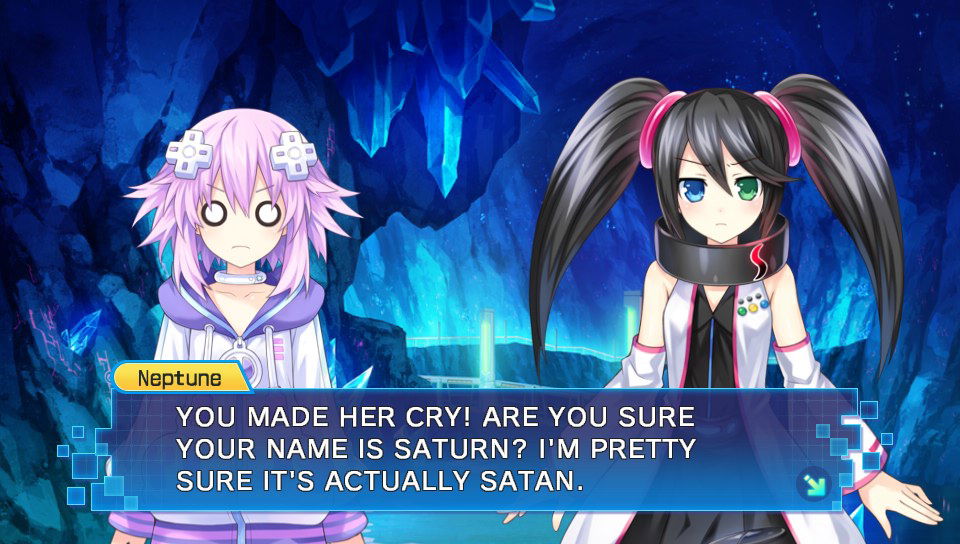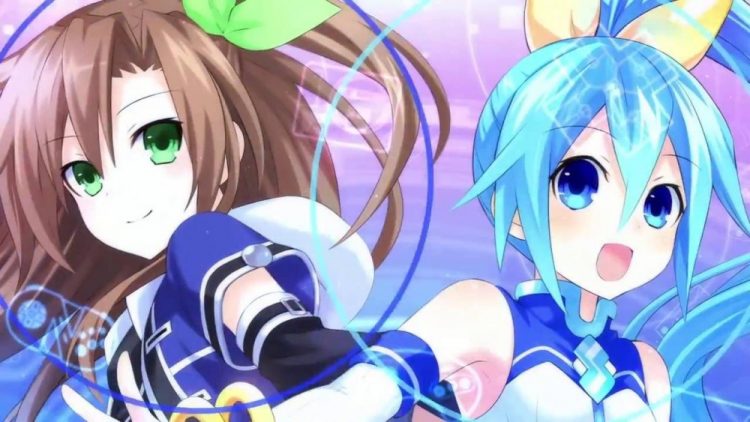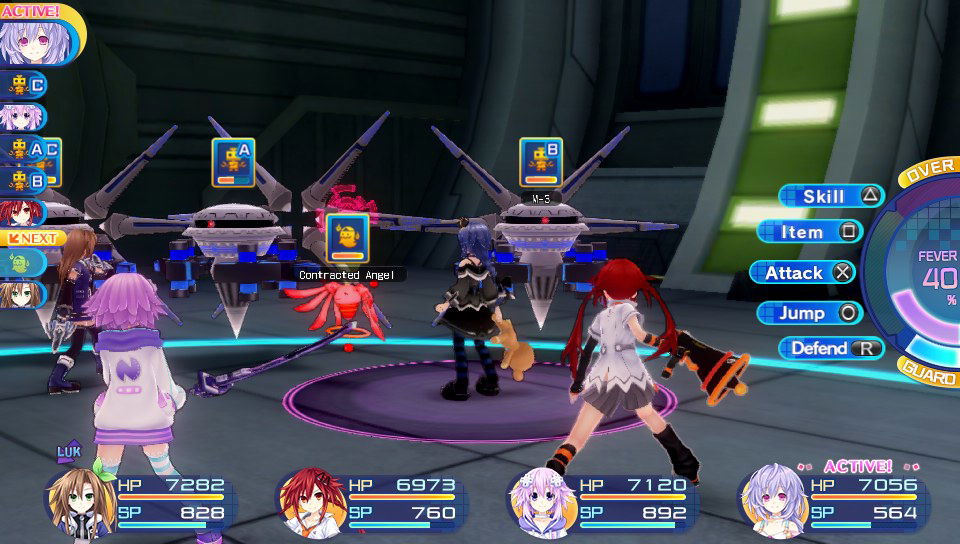Though crossovers tend to match series with a great deal in common, perhaps the most satisfying are the ones that are completely on the nose. With that said, this isn’t two dysfunctional families with alcoholic fathers, nagging mothers, and troublemaker sons; this is the clash of goddesses based on specific Sega consoles vying for power. This is Superdimension Neptune Vs. Sega Hard Girls.
Game Name: Superdimension Neptune Vs. Sega Hard Girls
Platform(s): Playstation Vita
Publisher(s): Idea Factory
Developer(s): Compile Heart, Felistella
Release Date: 10/18/2016
Price: $39.99
Taking place in a separate dimension from the mainline Hyperdimension Neptunia games, Superdimension Neptune Vs. Sega Hard Girls follows series mainstay IF (Iffy) as she makes a pilgrimage through the post-apocalyptic wastes to the grand library. It is within this library that the entire history of the world is kept, and though Iffy’s exact goal remains unclear, it is almost certainly linked to the past and its culture. There is not much time for literature through, as books all across the library begin disappearing and breaking down. Worse still, librarian Histroire reports that not only are the books disappearing, but the history contained within is disappearing from the world’s timeline as well. With that, Histoire enlists the help of Iffy and a mysterious amnesiac by the name of Segami to repair the timelines with the help of a time-travelling motorcycle.
Throughout the story, four different eras are visited, each with a patron goddess and hard girl: Mega Drive, Saturn, Game Gear, and Dreamcast. As the story goes, the Sega hard girls brought videogames to the masses, and the newfound faith in games birthed the goddesses. However, an inter-generational grudge fostered distrust of the goddesses within the hard girls, causing the war that would eventually leave the world a barren wasteland. Though Iffy means only to observe history and correct any anomalies, Segami actually pushes to prevent the conflict and end the bad blood between the two factions, all while preparing against a much more sinister foe.
Nep Vs. Sega Hard Girls actually reveals its major antagonist quite early in the story. As it were, a large tentacled monster called the “time eater” is eating the world’s history, gaining power with every event it consumes; this manifests itself in the form of quests. Each quest has a timer on it, and whenever a timer hits zero, the time eater consumes it and it is no longer available to the player, giving the time eater a combat buff along with it. Though this is an interesting system in-universe, it works to rob the player of a level of agency. In most RPGs, the player can skip a great deal of simple kill/fetch quests without real consequence, but here the choice is between monotony and a stronger big bad, which hardly feels like a choice at all.

In terms of actual gameplay, Nep Vs. Sega Hard Girls plays like the majority of Idea Factory games, which is to say a JRPG with 3d dungeons to explore and free-motion turn-based combat. Veterans to the Neptunia series will notice a shift in the combat system; where before each character’s turn composed of a single action, each character now is allowed any combination of actions until their action bar is full. Though this opens up possibilities to accomplish a great deal in a single turn, a fully filled action bar means that that particular character will have to wait longer before their next turn comes. It’s an interesting and actually well-balanced system, but in all each character is rather limited in terms of special moves and general attack options; the strategy that goes into planning out each turn is nice, but at the end of the day most of each turn will simply be filled with a single basic attack string with no variance.
As far as the characters and story go, I am somewhat conflicted. I’m a big fan of the Neptunia series, but this title feels a bit… off. The story at large is more or less a framing device to detail the goddess vs. hard girl war, but the war itself is rather lackluster. There are no grand battles nor sinister plots, rather, each era just consists of each faction’s current patron living a day-to-day life wherein they may or may not decide to attack the other party that day; it makes the entire conflict feel petty in a way. Even at that, each era’s arc is rather short and doesn’t accomplish as much as one would think.

With that said, each pairing of characters is pretty well balanced and makes for interesting interaction, respectively speaking: Mega Drive and Plutia are suspicious and oblivious, Saturn and Neptune are serious and laid-back, Game Gear and Nepgear are stern and lenient, Dreamcast and Uzume are feminine but warlike and warlike but feminine, and Iffy and Segami are both stubborn. This makes for solid pacing and generally fun dialogue throughout. However, this is somewhat stilted by the sheer amount of grinding that presents itself to progress through certain parts of the game is overwhelming at times, and quests have no indication of difficulty, meaning that it’s easy to sign up for a simple sounding quest and end up having to retire it and make the time eater that much stronger. This problem is made much worse by the fact that some of these high-level quests become available quite early in the game and have no warning of such, meaning that at any time the player can be duped into losing time and progress. Personally, I lost about an hour’s worth of progress by taking a quest who’s directive was simply “observe,” and got roped into a boss battle in which a round of all my strongest attacks combined didn’t even make a dent in the enemy health bar, resulting in a near-immediate game over and making me re-load at my last save point.
Ultimately, though Superdimension Neptune Vs. Sega Hard Girls does try new formulas and character interactions, the “bits, and pieces” formula through which the story is told is somewhat confusing. At face value, the story seems to be about Iffy helping Segami fix the timeline and defeat the time eater, but then there’s the matter of the war and the mystery of who’s pulling the strings in the conflict. If the former is the focus, there isn’t an awful lot of development in the characters, even with Segami slowly recovering from her amnesia. If it’s the latter, the conflicts therein are fairly shallow, only taking a handful of story progression quests each with several of them not offering anything meaningful.
Keeping all of that in mind, I really feel that pre-existing fans of the Neptunia franchise are the ones that will make all that much of this title; the characters are fun as always, but the dynamic interaction and sense of high adventure from the rest of the series leaves a hole in this entry, whether you’re familiar with the series or not.
*This copy was provided to us for review purposes. For more information on how we review video games and other media/technology, please go review our Review Guideline/Scoring Policy for more info.
Superdimension Neptune Vs. Sega Hard Girls
Thoughts as a fan
To be entirely honest, purely as a Hyperdimension Neptunia fan, I’m a bit conflicted on Superdimension Neptune Vs. Sega Hard Girls. On one hand, the game has a great cast and good interaction, but on the other a lot of it feels like it’s cut short to make way for the other eras’ stories. Even among the characters themselves, Neptune acts strangely out of character, feeling more like an alternative crowd high school student than the bombastic layabout that fans are used to, and Plutia acts a bit too aware of her alter ego’s depravity.
Honestly the greatest joy that I got out of this game was the ability to have Plutia and Uzume in a single party, but even then with only a couple of special moves each, something just feels missing.
With all of that said, Nep Vs. Sega Hard Girls isn’t a bad game, but it’s certainly missing some of the magic that brought me into the franchise to begin with.
Pros:
- Interesting quest format
- Well thought-out combat system
- Always good to see Plutia again
Cons:
- Stories lack depth
- Lack of attack options among characters
- Every era has the same dungeons, meaning a great deal of repetition
- Lack of warning as to recommended level for quests
-
They pronounce "Histy" with a hard H and that bugs me



